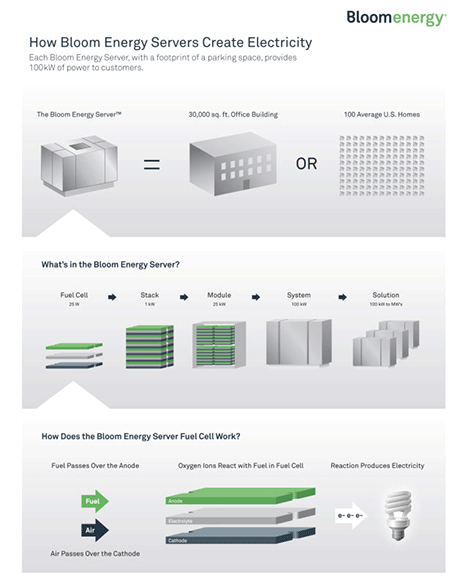How does the Bloom Box Energy Server work?

The use of fuel cells is becoming a trend worldwide. Unfortunately, the technology is still quite expensive and only affordable for large companies. In the future, in 5–10 years, it is quite possible that such elements will begin to appear in many people at the dacha.
The Bloom Box Energy Server installation consists of fuel cells, or electrochemical cells. One fuel cell consists of an anode, a cathode and an electrolyte between them. The fuel comes from the anode side, the oxidizer from the cathode side, and a reaction occurs that causes electrons to move in the fuel cell circuit, producing electricity.
- Bloom Box Energy Server is not really a server: this name is just a PR move. In fact, it is a modular generator set. Each "server" produces 100 kW of power and consists of thousands of fuel cells. Bloom Box costs 700−800 thousand dollars, with the cost of electricity 8−9 cents per kWh it pays off within three to five years.
- There are many different types of fuel cells. The most popular of them are methanol and hydrogen fuel cells, as well as zinc-air batteries. Bloom Box Energy Server consists of solid oxide fuel cells, the appeal of which is that they can be made from inexpensive materials and have high efficiency.
- Fuel cells can operate on various types of fuels, including conventional fuels, natural gas, biogas and ethanol.
- Until now, technical problems have stopped the commercial use of solid oxide fuel cells, but in the Bloom elements (“sand” baked into ceramic square elements covered in green and black paint), most of the problems were allegedly overcome. The Bloom website has a great presentation that shows how solid oxide fuel cells work.

')
- One of the biggest problems associated with the use of solid oxide fuel cells is that their work requires a very high temperature (ceramic squares become active only at temperatures up to 1000 ° C). This means that Bloom Energy elements have yet to prove their reliability. Already, the company had to replace elements in the eBay data center, which worked for them for only seven months, while in August the company announced plans to switch completely to these fuel cells in its data center under construction in Utah (USA). In general, Bloom expects its fuel cell batteries to shut off only twice during the 10-year service life of the devices.
- Bloom Box Energy Server generates electricity with an efficiency of 50 - 55%. For comparison: solar panels produce power with an efficiency of 10 - 15%, but unlike solar batteries, Bloom Energy server produces CO2 as a by-product. According to the information posted on The Energy Collective's website, "CO2 emissions when operating on natural gas will be no more than 0.36 kilograms per kilowatt-hour of electricity." This compares favorably with electricity generated at a coal-fired power plant — 0.9 kilograms per kilowatt-hour of electricity, and at a power plant running on natural gas — about 0.3 kilograms per kilowatt-hour of electricity. CO2 emissions on average in the electricity grid are 0.6–0.7 kilograms per kilowatt-hour of electricity. If the Bloom Box runs on landfill gas or biogas, it produces net emissions with zero carbon.
- In the end, Bloom hopes that a smaller version of the device can be used in private homes. Bloom Box for a residential house will produce 1 kW of power and will cost about $ 3000. But, probably, it will happen not earlier than in 10 years.
One of the first who tried out and began to actively implement this technology, became the largest operators of data centers. So, most recently, Microsoft announced its desire to reduce, and in the future to abandon, the use of diesel generator sets in favor of alternative backup power sources. AT & T last week announced an increase in the use of the Bloom Box , Apple announced the transfer of one of its data centers to fully renewable sources of energy, of which about 60% will be in fuel cells. And such messages appear more and more.
We hope that soon the first data centers and telecom operators will appear in Russia, which will use this technology, and we will deliver them to our dacha in the near future.
Source: https://habr.com/ru/post/153957/
All Articles